Effect of the Seasonal Climatic Variations on the Flavonoid Accumulation in Vitis vinifera cvs. ‘Muscat Hamburg’ and ‘Victoria’ Grapes under the Double Cropping System
Abstract
1. Introduction
2. Materials and Methods
2.1. Vineyard and Double Cropping System
2.2. Berry Sampling and Meteorological Data Collection
2.3. Extraction of Grapes Phenolic Compounds
2.4. HPLC-MS Analysis of Phenolic Compounds in Grapes
2.5. RNA Extraction and Transcriptome Sequencing
2.6. Statistical Analysis
3. Results
3.1. Meteorological Data
3.2. Anthocyanin Composition
3.3. Flavonol Composition
3.4. Flavanol Composition
3.5. Principal Component Analysis (PCA) and Orthogonal Partial Least-Squares Discrimination Analysis (OPLS-DA) Based on the Phenolic Profiles at Different Stages
3.6. Flavonoid Biosynthesis
3.7. Expression Profiles of Flavonoid Related Transcription Factors
4. Discussion
4.1. Effects of Growing Season on Anthocyanin Composition of ‘Muscat Hamburg’ Grape
4.2. Effects of Growing Season on Berries Flavonol Composition
4.3. Effects of Growing Season on Berries Flavanol Composition
5. Conclusions
Supplementary Materials
Author Contributions
Funding
Institutional Review Board Statement
Informed Consent Statement
Data Availability Statement
Acknowledgments
Conflicts of Interest
References
- Chen, W.-K.; Bai, X.-J.; Cao, M.-M.; Cheng, G.; Cao, X.-J.; Guo, R.-R.; Wang, Y.; He, L.; Yang, X.-H.; He, F.; et al. Dissecting the variations of ripening progression and flavonoid metabolism in grape berries grown under double cropping system. Front. Plant Sci. 2017, 8, 1912. [Google Scholar] [CrossRef]
- Cheng, G.; Zhou, S.H.; Zhang, J.; Huang, X.Y.; Bai, X.J.; Xie, T.L.; Guo, R.R.; Liu, J.B.; Yu, H.; Xie, L.J. Comparison of transcriptional expression patterns of phenols and carotenoids in ‘Kyoho’ grapes under a two-crop-a-year cultivation system. PLoS ONE 2019, 14, e0210322. [Google Scholar] [CrossRef] [PubMed]
- Chou, M.-Y.; Li, K.-T. Rootstock and seasonal variations affect Anthocyanin accumulation and quality traits of ’Kyoho’ grape berries in subtropical double cropping system. Vitis 2014, 53, 193–199. [Google Scholar]
- Favero, A.; Amorim, D.; Mota, R.; Soares, A.M.; Souza, C.; Regina, M. Double-pruning of ‘Syrah’ grapevines: A management strategy to harvest wine grapes during the winter in the Brazilian Southeast. Vitis 2011, 50, 151–158. [Google Scholar]
- Jackson, D.I.; Lombard, P.B. Environmental and management practices affecting grape composition and wine quality—A review. Am. J. Enol. Vitic. 1993, 44, 409. [Google Scholar]
- Zhu, L.; Huang, Y.; Zhang, Y.; Xu, C.; Lu, J.; Wang, Y. The growing season impacts the accumulation and composition of flavonoids in grape skins in two-crop-a-year viticulture. J. Food Sci. Technol. 2017, 54, 2861–2870. [Google Scholar] [CrossRef] [PubMed]
- Xu, C.; Zhang, Y.; Zhu, L.; Huang, Y.; Lu, J. Influence of growing season on phenolic compounds and antioxidant properties of grape berries from vines grown in subtropical climate. J. Agric. Food Chem. 2011, 59, 1078–1086. [Google Scholar] [CrossRef] [PubMed]
- Wang, Y.; He, Y.-N.; Chen, W.-K.; He, F.; Chen, W.; Cai, X.-D.; Duan, C.-Q.; Wang, J. Effects of cluster thinning on vine photosynthesis, berry ripeness and flavonoid composition of Cabernet Sauvignon. Food Chem. 2018, 248, 101–110. [Google Scholar] [CrossRef]
- Brandt, M.; Scheidweiler, M.; Rauhut, D.; Patz, C.-D.; Will, F.; Zorn, H.; Stoll, M. The influence of temperature and solar radiation on phenols in berry skin and maturity parameters of Vitis vinifera L. cv. Riesling. OENO One 2019, 53, 287–302. [Google Scholar] [CrossRef]
- Yamane, T.; Jeong, S.; Goto-Yamamoto, N.; Koshita, Y.; Kobayashi, S. Effects of temperature on anthocyanin biosynthesis in grape berry skins. Am. J. Enol. Vitic. 2006, 57, 54–59. [Google Scholar]
- Mori, K.; Goto-Yamamoto, N.; Kitayama, M.; Hashizume, K. Loss of anthocyanins in red-wine grape under high temperature. J. Exp. Bot. 2007, 58, 1935–1945. [Google Scholar] [CrossRef]
- Cohen, S.D.; Tarara, J.M.; Gambetta, G.A.; Matthews, M.A.; Kennedy, J.A. Impact of diurnal temperature variation on grape berry development, proanthocyanidin accumulation, and the expression of flavonoid pathway genes. J. Exp. Bot. 2012, 63, 2655–2665. [Google Scholar] [CrossRef] [PubMed]
- Matus, J.; Loyola Muñoz, R.; Vega, A.; Peña-Neira, A.; Bordeu, E.; Arce-johnson, P.; Alcalde, J. Post-veraison sunlight exposure induces MYB-mediated transcriptional regulation of anthocyanin and flavonol synthesis in berry skins of Vitis vinifera. J. Exp. Bot. 2009, 60, 853–867. [Google Scholar] [CrossRef] [PubMed]
- Sun, R.-Z.; Cheng, G.; Li, Q.; He, Y.-N.; Wang, Y.; Lan, Y.; Li, S.-Y.; Zhu, Y.-R.; Song, W.-F.; Zhang, X.; et al. Light-induced variation in phenolic compounds in Cabernet Sauvignon grapes (Vitis vinifera L.) involves extensive transcriptome reprogramming of biosynthetic enzymes, transcription factors, and phytohormonal regulators. Front. Plant Sci. 2017, 8, 547. [Google Scholar] [CrossRef] [PubMed]
- Spayd, S.; Tarara, J.; Mee, D.L.; Ferguson, J.C. Separation of sunlight and temperature effects on the composition of Vitis vinifera cv. Merlot berries. Am. J. Enol. Vitic. 2002, 53, 171–182. [Google Scholar]
- Deluc, L.G.; Quilici, D.R.; Decendit, A.; Grimplet, J.; Wheatley, M.D.; Schlauch, K.A.; Mérillon, J.-M.; Cushman, J.C.; Cramer, G.R. Water deficit alters differentially metabolic pathways affecting important flavor and quality traits in grape berries of Cabernet Sauvignon and Chardonnay. BMC Genom. 2009, 10, 212. [Google Scholar] [CrossRef]
- Ferrara, G.; Gallotta, A.; Pacucci, C.; Matarrese, A.M.S.; Mazzeo, A.; Giancaspro, A.; Gadaleta, A.; Piazzolla, F.; Colelli, G. The table grape ‘Victoria’ with a long shaped berry: A potential mutation with attractive characteristics for consumers. J. Sci. Food Agric. 2017, 97, 5398–5405. [Google Scholar] [CrossRef]
- Fenoll, J.; Manso, A.; Hellín, P.; Ruiz, L.; Flores, P. Changes in the aromatic composition of the Vitis vinifera grape Muscat Hamburg during ripening. Food Chem. 2009, 114, 420–428. [Google Scholar] [CrossRef]
- Coombe, B.G. Growth stages of the grapevine: Adoption of a system for identifying grapevine growth stages. Aust. J. Grape Wine Res. 1995, 1, 104–110. [Google Scholar] [CrossRef]
- Wang, Y.; He, Y.-N.; He, L.; He, F.; Chen, W.; Duan, C.-Q.; Wang, J. Changes in global aroma profiles of Cabernet Sauvignon in response to cluster thinning. Food Res. Int. 2019, 122, 56–65. [Google Scholar] [CrossRef] [PubMed]
- Liang, N.N.; He, F.; Pan, Q.H.; Wang, J.; Reeves, M.J.; Duan, C.Q. Optimization of sample preparation and phloroglucinol analysis of Marselan grape skin proanthocyanidins using HPLC-DAD-ESI- MS/MS. S. Afr. J. Enol. Vitic. 2012, 33, 122–131. [Google Scholar] [CrossRef]
- He, F.; Liang, N.-N.; Mu, L.; Pan, Q.-H.; Wang, J.; Reeves, M.J.; Duan, C.-Q. Anthocyanins and their variation in red wines I. Monomeric anthocyanins and their color expression. Molecules 2012, 17, 1571–1601. [Google Scholar] [CrossRef]
- Mattivi, F.; Guzzon, R.; Vrhovsek, U.; Stefanini, M.; Velasco, R. Metabolite profiling of grape: flavonols and anthocyanins. J. Agric. Food Chem. 2006, 54, 7692–7702. [Google Scholar] [CrossRef]
- Degu, A.; Hochberg, U.; Sikron, N.; Venturini, L.; Buson, G.; Ghan, R.; Plaschkes, I.; Batushansky, A.; Chalifa-Caspi, V.; Mattivi, F.; et al. Metabolite and transcript profiling of berry skin during fruit development elucidates differential regulation between Cabernet Sauvignon and Shiraz cultivars at branching points in the polyphenol pathway. BMC Plant Biol. 2014, 14, 188. [Google Scholar] [CrossRef]
- Bogs, J.; Ebadi, A.; McDavid, D.; Robinson, S.P. Identification of the flavonoid hydroxylases from grapevine and their regulation during fruit development. Plant Physiol. 2006, 140, 279–291. [Google Scholar] [CrossRef]
- Fujita, A.; Goto-Yamamoto, N.; Aramaki, I.; Hashizume, K. Organ-specific transcription of putative flavonol synthase genes of grapevine and effects of plant hormones and shading on flavonol biosynthesis in grape berry skins. Biosci. Biotechnol. Biochem. 2006, 70, 632–638. [Google Scholar] [CrossRef]
- Bogs, J.; Downey, M.; Harvey, J.; Ashton, A.; Tanner, G.; Robinson, S. Proanthocyanidin synthesis and expression of genes encoding leucoanthocyanidin reductase and anthocyanidin reductase in developing grape berries and grapevine leaves. Plant Physiol. 2005, 139, 652–663. [Google Scholar] [CrossRef] [PubMed]
- Ford, C.M.; Boss, P.K.; Høj, P.B. Cloning and characterization of Vitis vinifera UDP-glucose: Flavonoid-3-O-glucosyltransferase, a homologue of the enzyme encoded by the maize Bronze-1 locus that may primarily serve to glucosylate anthocyanidins in vivo. J Biol. Chem. 1998, 273, 9224–9233. [Google Scholar] [CrossRef]
- Fournier-Level, A.; Hugueney, P.; Verriès, C.; This, P.; Ageorges, A. Genetic mechanisms underlying the methylation level of anthocyanins in grape (Vitis vinifera L.). BMC Plant Biol. 2011, 11, 179. [Google Scholar] [CrossRef]
- Rinaldo, A.R.; Cavallini, E.; Jia, Y.; Moss, S.M.A.; McDavid, D.A.J.; Hooper, L.C.; Robinson, S.P.; Tornielli, G.B.; Zenoni, S.; Ford, C.M.; et al. A grapevine anthocyanin acyltransferase, transcriptionally regulated by VvMYBA, can produce most acylated anthocyanins present in grape skins. Plant Physiol. 2015, 169, 1897–1916. [Google Scholar] [CrossRef] [PubMed]
- Kobayashi, S.; Ishimaru, M.; Hiraoka, K.; Honda, C. Myb-related genes of the Kyoho grape (Vitis labruscana) regulate anthocyanin biosynthesis. Planta 2002, 215, 924–933. [Google Scholar] [CrossRef]
- Walker, A.R.; Lee, E.; Bogs, J.; McDavid, D.A.J.; Thomas, M.R.; Robinson, S.P. White grapes arose through the mutation of two similar and adjacent regulatory genes. Plant J. 2007, 49, 772–785. [Google Scholar] [CrossRef]
- Bogs, J.; Jaffe, F.; Takos, A.; Walker, A.; Robinson, S. The grapevine transcription factor VvMYBPA1 regulates proanthocyanidin synthesis during fruit development. Plant Physiol. 2007, 143, 1347–1361. [Google Scholar] [CrossRef] [PubMed]
- Deluc, L.; Barrieu, F.; Marchive, C.; Lauvergeat, V.; Décendit, A.; Richard, T.; Carde, J.-P.; Merillon, J.-M.; Hamdi, S. Characterization of a grapevine R2R3-MYB transcription factor that regulates the phenylpropanoid pathway. Plant Physiol. 2006, 140, 499–511. [Google Scholar] [CrossRef] [PubMed]
- Deluc, L.; Bogs, J.; Walker, A.; Ferrier, T.; Décendit, A.; Merillon, J.-M.; Robinson, S.; Barrieu, F. The transcription factor VvMYB5b contributes to the regulation of anthocyanin and proanthocyanidin biosynthesis in developing grape berries. Plant Physiol. 2008, 147, 2041–2053. [Google Scholar] [CrossRef]
- Cavallini, E.; Matus, J.; Finezzo, L.; Zenoni, S.; Loyola Muñoz, R.; Guzzo, F.; Schlechter, R.; Ageorges, A.; Arce-johnson, P.; Tornielli, G.B. The phenylpropanoid pathway is controlled at different branches by a set of R2R3-MYB C2 repressors in grapevine. Plant Physiol. 2015, 167, 1448–1470. [Google Scholar] [CrossRef]
- Carbonell-Bejerano, P.; Santa María, E.; Torres-Pérez, R.; Royo, C.; Lijavetzky, D.; Bravo, G.; Aguirreolea, J.; Sánchez-Díaz, M.; Antolín, M.C.; Martínez-Zapater, J.M. Thermotolerance responses in ripening berries of Vitis vinifera L. cv Muscat Hamburg. Plant Cell Physiol. 2013, 54, 1200–1216. [Google Scholar] [CrossRef]
- Czemmel, S.; Höll, J.; Loyola, R.; Arce-Johnson, P.; Alcalde, J.A.; Matus, J.T.; Bogs, J. Transcriptome-wide identification of novel UV-B- and light modulated flavonol pathway genes controlled by VviMYBF1. Front. Plant Sci. 2017, 8, 1084. [Google Scholar] [CrossRef]
- Malacarne, G.; Coller, E.; Czemmel, S.; Vrhovsek, U.; Engelen, K.; Goremykin, V.; Bogs, J.; Moser, C. The grapevine VvibZIPC22 transcription factor is involved in the regulation of flavonoid biosynthesis. J. Exp. Bot. 2016, 67, 3509–3522. [Google Scholar] [CrossRef] [PubMed]
- De Rosas, I.; Ponce, M.T.; Malovini, E.; Deis, L.; Cavagnaro, B.; Cavagnaro, P. Loss of anthocyanins and modification of the anthocyanin profiles in grape berries of Malbec and Bonarda grown under high temperature conditions. Plant Sci. 2017, 258, 137–145. [Google Scholar] [CrossRef]
- Pastore, C.; Dal Santo, S.; Zenoni, S.; Movahed, N.; Allegro, G.; Valentini, G.; Filippetti, I.; Tornielli, G.B. Whole plant temperature manipulation affects flavonoid metabolism and the transcriptome of grapevine berries. Front. Plant Sci. 2017, 8, 929. [Google Scholar] [CrossRef] [PubMed]
- Tarara, J.; Lee, J.; Spayd, S.; Scagel, C.F. Berry temperature and solar radiation alter acylation, proportion, and concentration of anthocyanin in Merlot grapes. Am. J. Enol. Vitic. 2008, 59, 235–247. [Google Scholar]
- Rodriguez-Saona, L.E.; Giusti, M.M.; Wrolstad, R.E. Color and pigment stability of red radish and red-fleshed potato anthocyanins in juice model systems. J. Food Sci. 1999, 64, 451–456. [Google Scholar] [CrossRef]
- Martínez-Lüscher, J.; Brillante, L.; Kurtural, S.K. Flavonol profile is a reliable indicator to assess canopy architecture and the exposure of red wine grapes to solar radiation. Front. Plant Sci. 2019, 10, 10. [Google Scholar] [CrossRef]
- Gouot, J.C.; Smith, J.P.; Holzapfel, B.P.; Walker, A.R.; Barril, C. Grape berry flavonoids: A review of their biochemical responses to high and extreme high temperatures. J. Exp. Bot. 2019, 70, 397–423. [Google Scholar] [CrossRef] [PubMed]
- Azuma, A.; Yakushiji, H.; Koshita, Y.; Kobayashi, S. Flavonoid biosynthesis-related genes in grape skin are differentially regulated by temperature and light conditions. Planta 2012, 236, 1067–1080. [Google Scholar] [CrossRef]
- Mori, K.; Sugaya, S.; Gemma, H. Regulatory mechanism of anthocyanin biosynthesis in ‘Kyoho’ grape berries grown under different temperature conditions. Environ. Cont. Biol. 2004, 42, 21–30. [Google Scholar] [CrossRef]
- Bonada, M.; Jeffery, D.; Petrie, P.; Moran, M.; Sadras, V. Impact of elevated temperature and water deficit on the chemical and sensory profiles of Barossa Shiraz grapes and wines. Aust. J. Grape Wine Res. 2015, 21, 240–253. [Google Scholar] [CrossRef]
- Poudel, P.; Mochioka, R.; Beppu, K.; Kataoka, I. Influence of temperature on berry composition of interspecific hybrid wine grape ‘Kadainou R-1’ (Vitis ficifolia var. ganebu × V. vinifera ‘Muscat of Alexandria’). J. Jpn. Soc. Hort. Sci. 2009, 78, 169–174. [Google Scholar] [CrossRef][Green Version]
- Downey, M.O.; Harvey, J.S.; Robinson, S.P. Analysis of tannins in seeds and skins of Shiraz grapes throughout berry development. Aust. J. Grape Wine Res. 2003, 9, 15–27. [Google Scholar] [CrossRef]
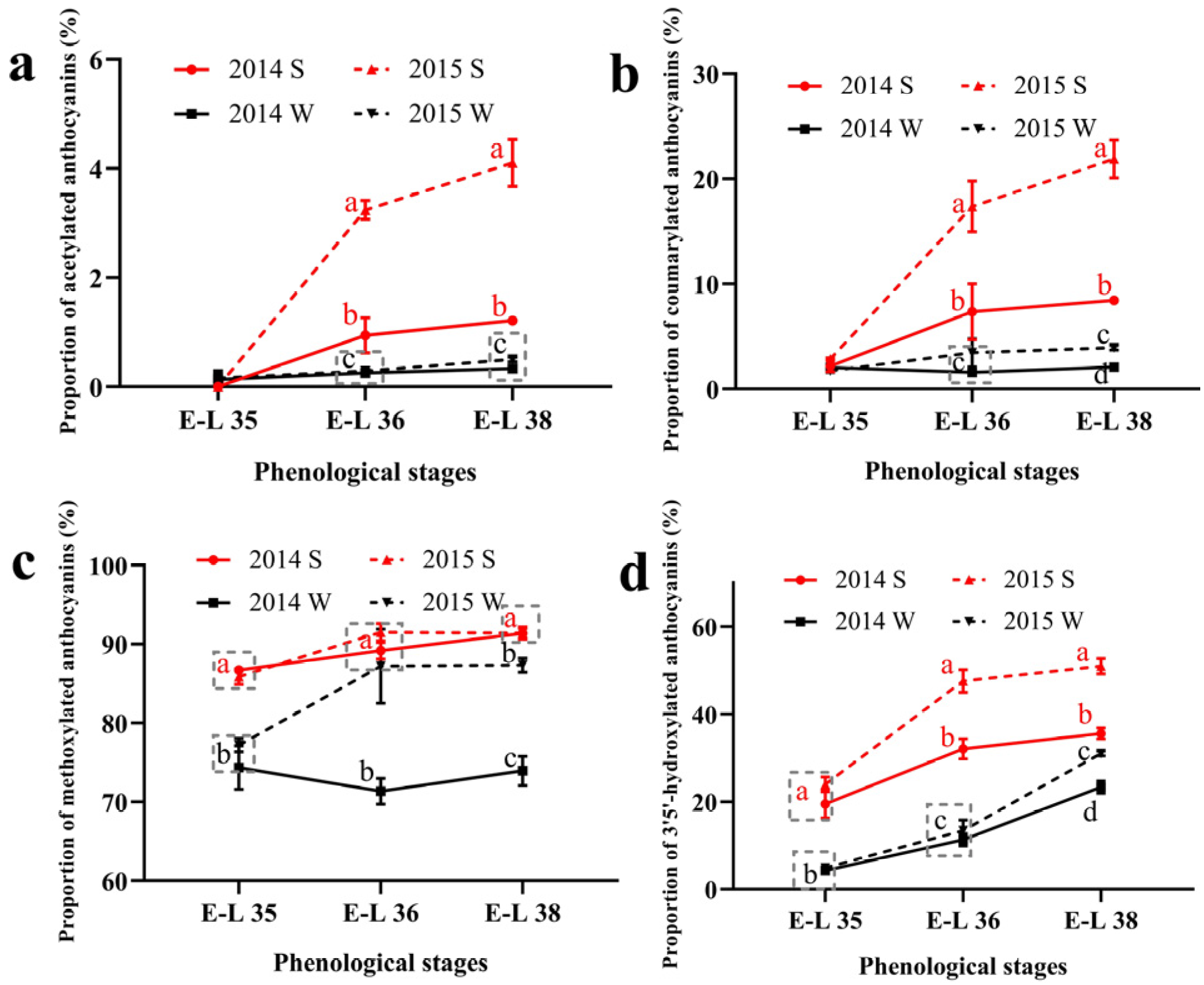
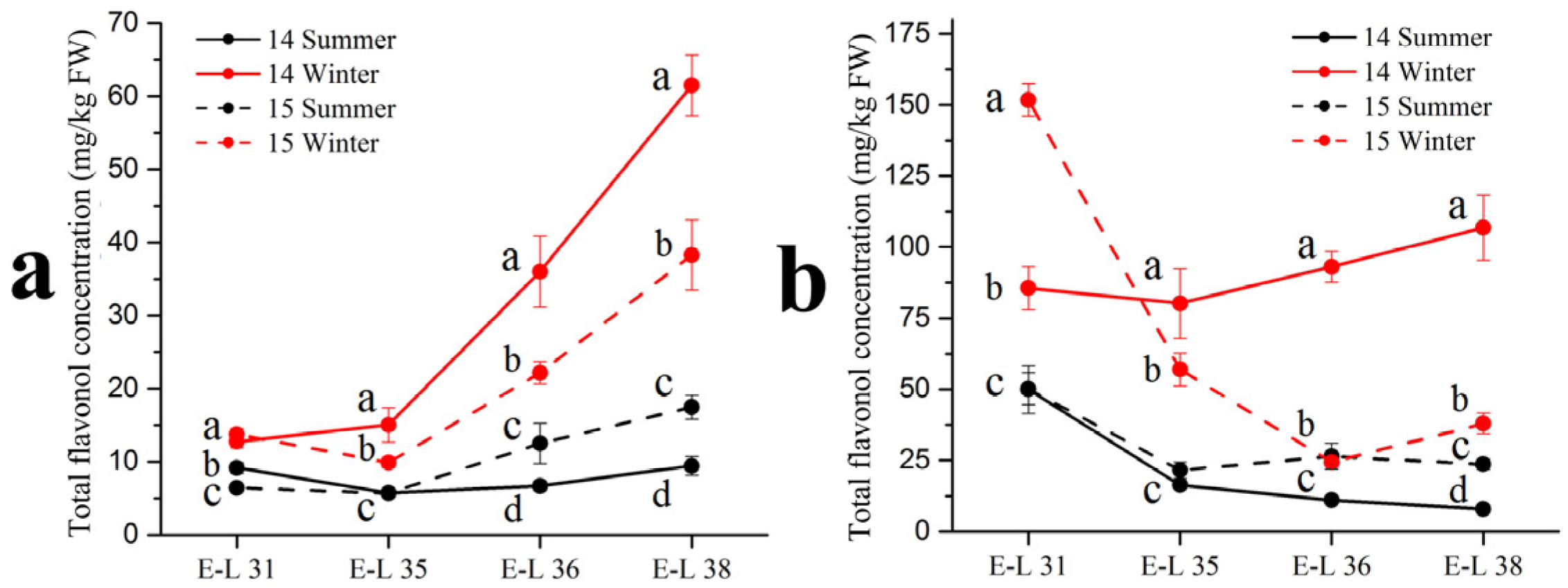

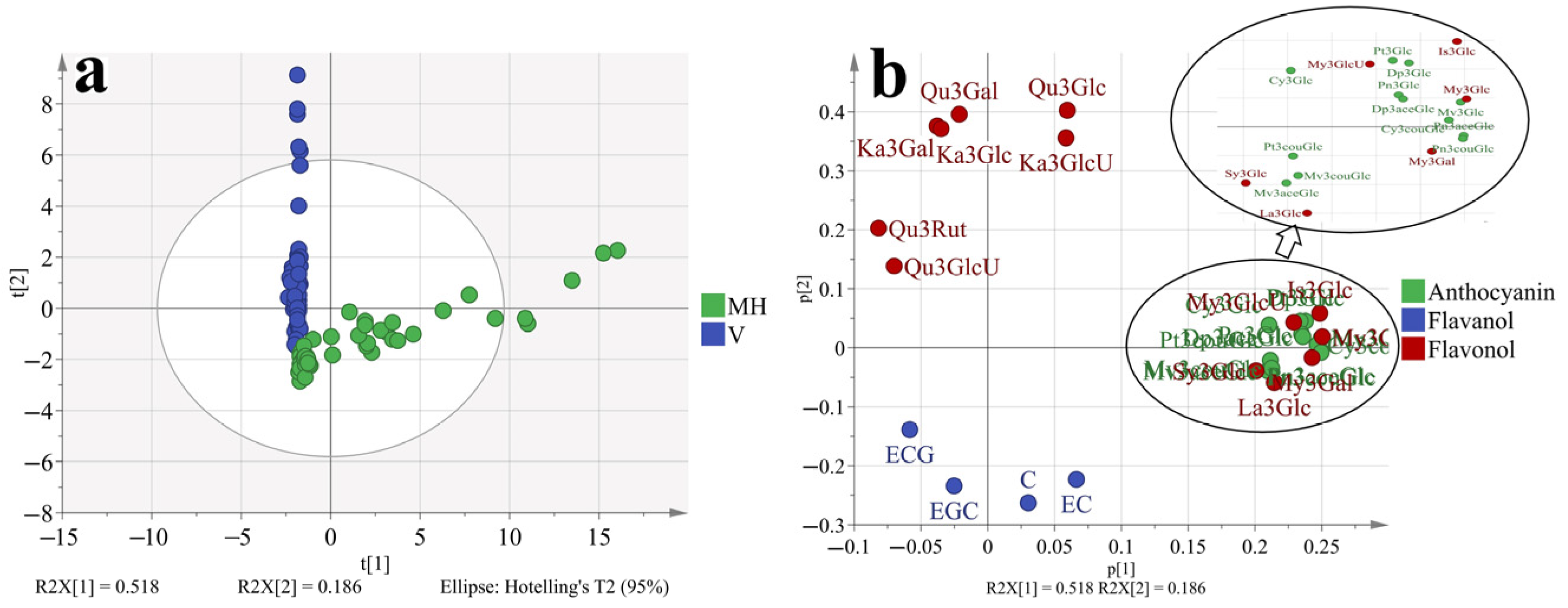
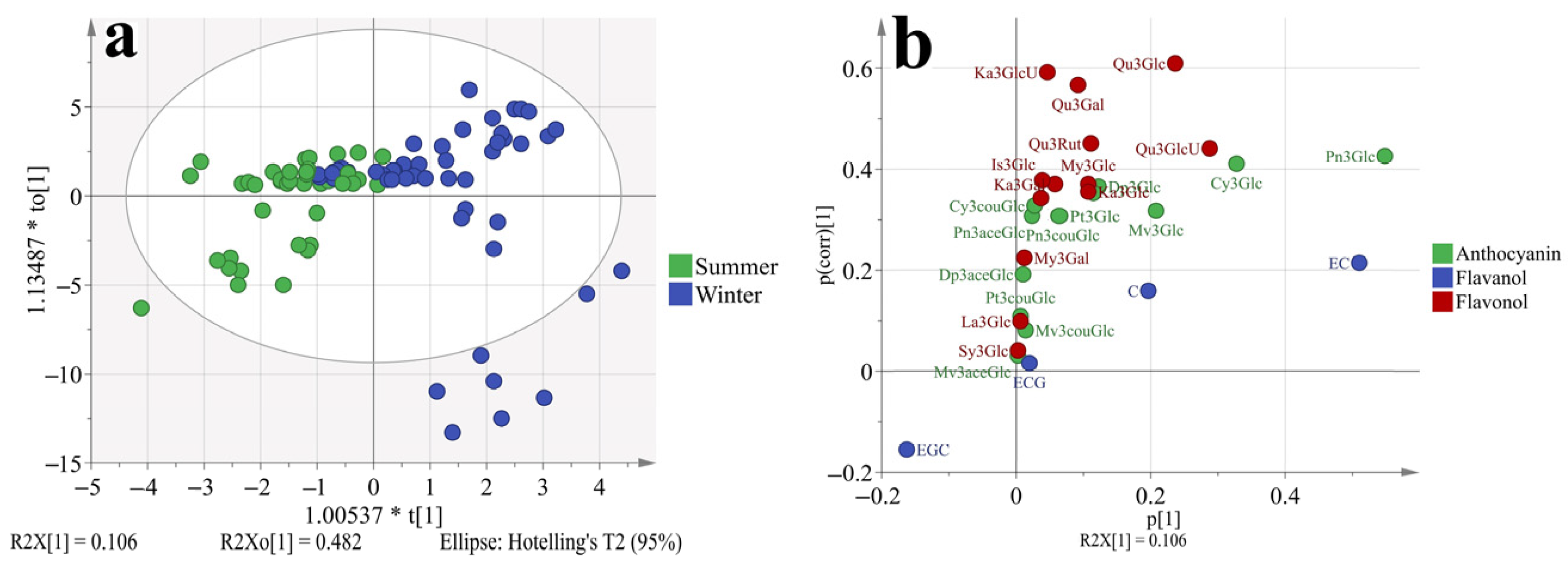
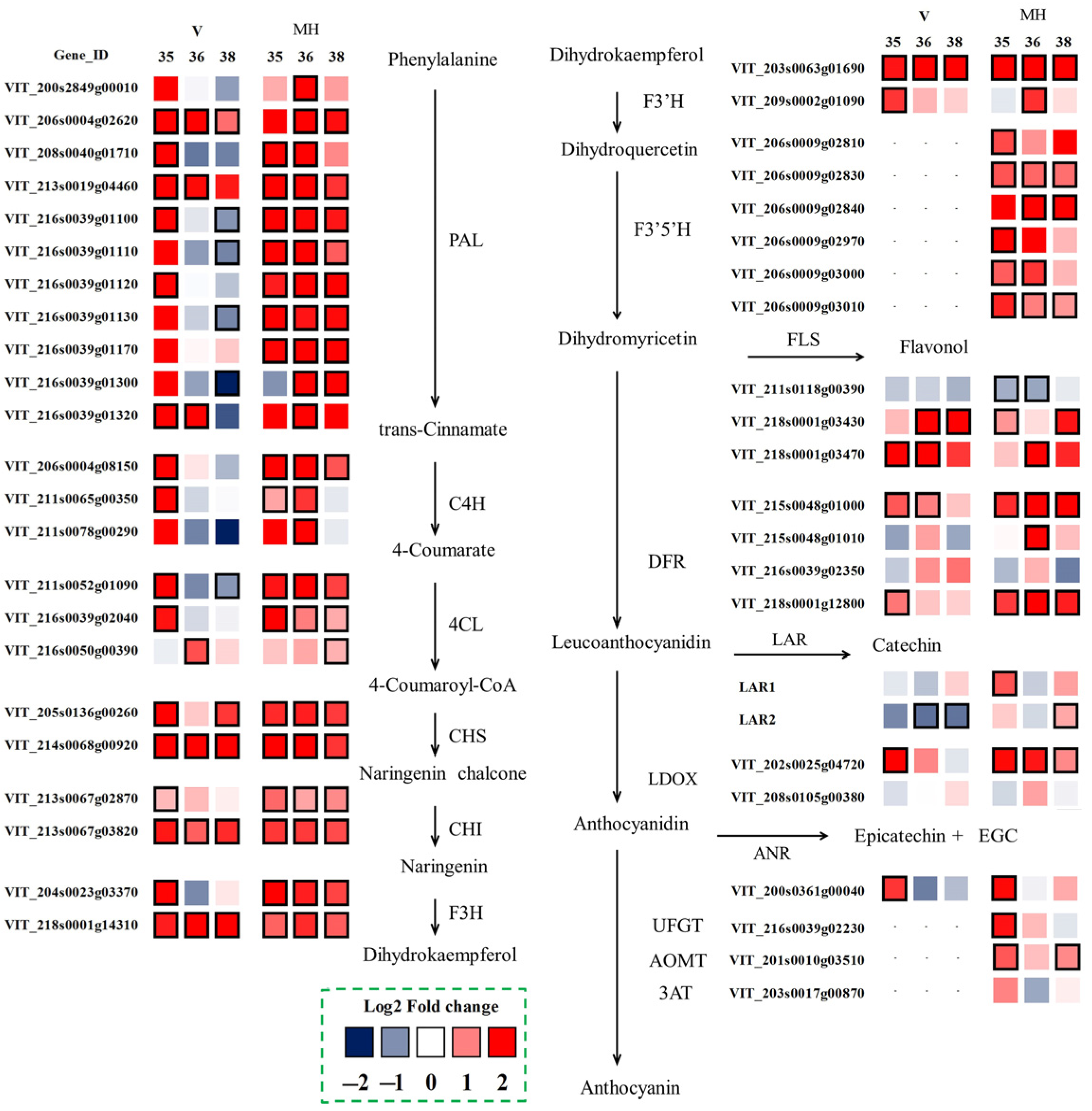
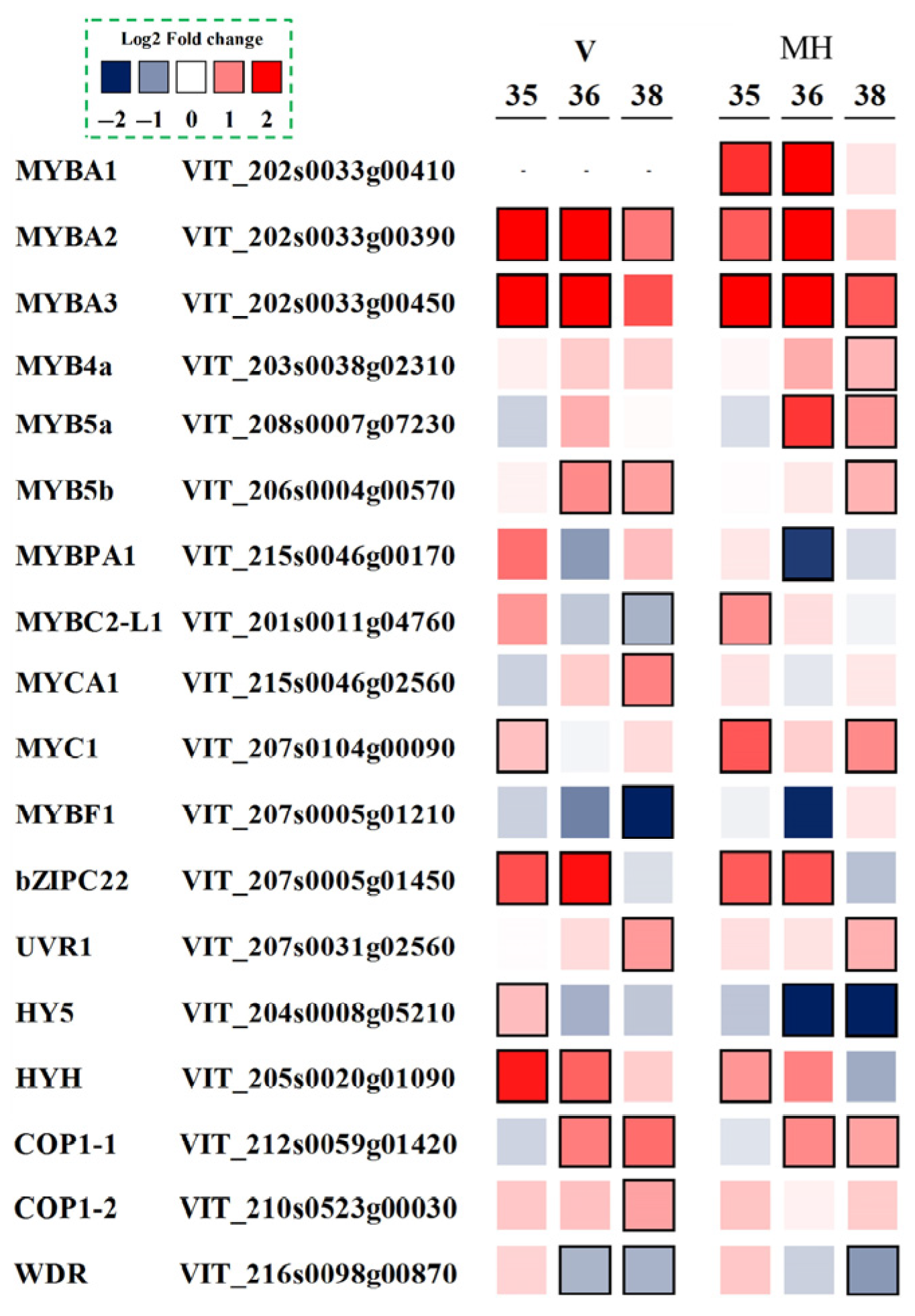
| Year | Season | Variety | Development Stages | GDD (°C) | Average Daily Temperature (°C) | High Temperature (>35 °C) Hours | Cumulative PAR (103 μmol/m2/s) | Cumulative Sunshine Hours (h) | Cumulative Rainfall (mm) |
|---|---|---|---|---|---|---|---|---|---|
| 2014 | Summer | MH and V | Stage I | 1021.4 | 27.9 | 209 | 23.7 | 204.7 | 147.4 |
| Stage II | 358.7 | 29.9 | 89 | 7.2 | 68.5 | 60.8 | |||
| Stage III | 146.3 | 30.9 | 39 | 3.0 | 24.6 | 5.7 | |||
| Whole season | 1526.4 | 28.6 | 337 | 33.9 | 297.8 | 213.9 | |||
| Winter | MH and V | Stage I | 958.1 | 23.1 | 89 | 27.3 | 341.1 | 447.1 | |
| Stage II | 85.9 | 13.4 | 0 | 6.6 | 86.1 | 30.3 | |||
| Stage III | 54.8 | 13.9 | 0 | 4.5 | 68.8 | 16.8 | |||
| Whole season | 1098.8 | 19.3 | 89 | 38.4 | 506.3 | 494.2 | |||
| 2015 | Summer | V | Stage I | 968.9 | 28.9 | 205 | 27.5 | 276.5 | 306.8 |
| Stage II | 443.1 | 31.1 | 96 | 11.0 | 99.8 | 66.2 | |||
| Stage III | 262.7 | 31.9 | 61 | 6.8 | 78.8 | 16.0 | |||
| Whole season | 1674.7 | 29.7 | 362 | 45.2 | 455.1 | 386.0 | |||
| Summer | MH | Stage I | 1085.8 | 29.0 | 229 | 30.1 | 295.1 | 346.4 | |
| Stage II | 771.0 | 31.4 | 229 | 20.8 | 224.4 | 39.6 | |||
| Stage III | 238.8 | 28.4 | 37 | 5.65 | 45.6 | 213.8 | |||
| Whole season | 2095.6 | 29.7 | 495 | 56.4 | 565.1 | 599.8 | |||
| Winter | MH and V | Stage I | 854.0 | 25.3 | 54 | 24.0 | 264.8 | 143.6 | |
| Stage II | 236.1 | 21.2 | 1 | 57.8 | 40.9 | 59.4 | |||
| Stage III | 256.9 | 15.1 | 0 | 94.7 | 73.4 | 173.0 | |||
| Whole season | 1347.0 | 20.3 | 55 | 39.2 | 379.1 | 376.0 |
| Compound | 2014 Summer | 2014 Winter | 2015 Summer | 2015 Winter | S | V | S × V |
|---|---|---|---|---|---|---|---|
| Delphinidin-3-O-glucoside | 2.1 ± 0.5c | 31.6 ± 5.0a | 1.0 ± 0.1d | 13.1 ± 3.6b | *** | *** | ** |
| Cyanidin-3-O-glucoside | 5.1 ± 1.0c | 159.4 ± 20.0a | 1.5 ± 0.4d | 35.6 ± 0.8b | *** | *** | *** |
| Petunidin-3-O-glucoside | 2.4 ± 0.6c | 31.3 ± 5.5a | 1.1 ± 0.2c | 10.8 ± 2.3b | *** | *** | *** |
| Peonidin-3-O-glucoside | 48.4 ± 6.2c | 395.5 ± 16.9a | 12.0 ± 2.1d | 223.5 ± 21.2b | *** | *** | *** |
| Malvidin-3-O-glucoside | 25.2 ± 4.6b | 104.4 ± 6.7a | 10.4 ± 1.1c | 89.2 ± 8.6a | *** | ** | ns |
| Delphinidin-3-O-acetylglucoside | 0.2 ± 0.0b | 0.7 ± 0.1a | 0.3 ± 0.1b | 0.3 ± 0.0b | ** | ns | ** |
| Peonidin-3-O-acetylglucoside | 0.6 ± 0.1b | 1.3 ± 0.1a | 0.5 ± 0.1b | 1.0 ± 0.1a | *** | * | ns |
| Malvidin-3-O-acetylglucoside | 0.4 ± 0.1b | 0.5 ± 0.1ab | 0.7 ± 0.1a | 0.7 ± 0.1a | ns | ** | ns |
| Cyanidin-3-O-coumarylglucoside | 0.6 ± 0.1bc | 1.6 ± 0.2a | 0.3 ± 0.1c | 0.9 ± 0.1b | *** | *** | ** |
| Petunidin-3-O-coumarylglucoside | 0.2 ± 0.0b | 0.5 ± 0.1a | 0.3 ± 0.0b | 0.3 ± 0.1b | ** | ns | ** |
| Peonidin-3-O-coumarylglucoside | 4.5 ± 0.6b | 9.8 ± 1.0a | 1.5 ± 0.2b | 5.3 ± 0.3a | *** | ns | * |
| Malvidin-3-O-coumarylglucoside | 2.4 ± 0.2c | 3.6 ± 0.1b | 4.1 ± 0.2b | 7.6 ± 0.6a | *** | *** | *** |
| ΣDp (%) | 2.5 ± 0.2b | 4.3 ± 0.5a | 3.5 ± 0.2ab | 3.4 ± 0.8ab | * | ns | ** |
| ΣPt (%) | 2.8 ± 0.3b | 4.3 ± 0.6a | 3.9 ± 0.0ab | 2.9 ± 0.8b | ns | ns | ** |
| ΣMv (%) | 30.3 ± 0.8b | 14.7 ± 0.6d | 43.5 ± 2.0a | 24.8 ± 0.9c | *** | *** | ns |
| ΣCy (%) | 6.2 ± 0.4c | 21.7 ± 1.4a | 5.1 ± 0.5c | 9.3 ± 0.6b | *** | *** | *** |
| ΣPn (%) | 58.3 ± 1.6a | 55.0 ± 2.6b | 44.0 ± 1.3c | 59.7 ± 1.0a | *** | ** | *** |
| Total anthocyanin concentration | 92.0 ± 13.8c | 740.9 ± 47.4a | 35.1 ± 4.8d | 394.0 ± 30.4b | *** | *** | *** |
| Compound | ‘Muscat Hamburg’ | ‘Victoria’ | ||||||
|---|---|---|---|---|---|---|---|---|
| 2014 Summer | 2014 Winter | 2015 Summer | 2015 Winter | 2014 Summer | 2014 Winter | 2015 Summer | 2015 Winter | |
| Myglu | 0.3 ± 0.2c | 3.5 ± 0.5a | 0.3 ± 0.0c | 0.8 ± 0.1b | - | - | - | - |
| Mygal | 0.1 ± 0.1c | 0.6 ± 0.1a | 0.4 ± 0.0b | 0.7 ± 0.1a | - | - | - | - |
| Mygluc | 2.7 ± 0.5c | 20.7 ± 1.7a | 2.8 ± 0.3c | 14.4 ± 2.8b | - | - | - | - |
| Qugal | 0.2 ± 0.0d | 1.6 ± 0.1a | 0.5 ± 0.1c | 0.7 ± 0.1b | 0.1 ± 0.0c | 6.9 ± 0.9a | 0.9 ± 0.4bc | 1.6 ± 0.2b |
| Qugluc | 2.6 ± 0.2d | 10.1 ± 0.3a | 4.0 ± 0.3c | 6.7 ± 0.8b | 5.8 ± 0.9c | 22.3 ± 1.6a | 15.2 ± 2.2b | 15.9 ± 2.1b |
| Qurut | - | - | - | - | 0.5 ± 0.1c | 4.5 ± 1.0a | 1.1 ± 0.2bc | 2.1 ± 0.2b |
| Quglu | 2.5 ± 0.4d | 20.2 ± 1.2a | 7.2 ± 1.0c | 10.9 ± 1.2b | 1.3 ± 0.4c | 38.0 ± 4.5a | 9.0 ± 3.4b | 10.6 ± 1.0b |
| Laglu | 0.2 ± 0.0b | 0.54 ± 0.1 a | 0.58 ± 0.1a | 0.67 ± 0.2a | - | - | - | - |
| Kagal | Trace | 0.2 ± 0.1 | Trace | Trace | Trace | 7.1 ± 0.8a | 0.5 ± 0.2c | 1.5 ± 0.1b |
| Kagluc | 0.1 ± 0.0c | 1.0 ± 0.3a | 0.3 ± 0.0c | 0.5 ± 0.1b | 0.1 ± 0.0d | 1.0 ± 0.1a | 0.6 ± 0.2b | 0.4 ± 0.0c |
| Kaglu | Trace | 0.7 ± 0.1a | 0.1 ± 0.0c | 0.4 ± 0.1b | 0.10 ± 0.1d | 26.7 ± 2.8a | 1.7 ± 0.8c | 5.9 ± 0.6b |
| Isglu | 0.6 ± 0.1c | 2.4 ± 0.2a | 1.1 ± 0.1b | 2.1 ± 0.3a | Trace | 0.4 ± 0.0a | Trace | 0.1 ± 0.0b |
| Syglu | 0.1 ± 0.0c | 0.2 ± 0.1c | 0.3 ± 0.0b | 0.4 ± 0.1a | - | - | - | - |
| ΣMy (%) | 32.7 ± 1.6b | 40.3 ± 1.0a | 20.1 ± 1.8c | 41.4 ± 4.3a | - | - | - | - |
| ΣQu (%) | 56.4 ± 1.7b | 51.7 ± 1.0c | 66.4 ± 1.8a | 48.0 ± 4.0c | 97.6 ± 0.6a | 67.1 ± 0.3d | 90.7 ± 1.9b | 79.4 ± 0.5c |
| ΣKa (%) | 2.5 ± 0.1b | 0.9 ± 0.1d | 3.3 ± 0.3a | 1.8 ± 0.1c | 2.4 ± 0.6d | 32.6 ± 0.3a | 9.3 ± 1.9c | 20.3 ± 0.5b |
| ΣLa (%) | 1.2 ± 0.1b | 2.9 ± 0.7a | 2.6 ± 0.0a | 2.3 ± 0.1a | - | - | - | - |
| ΣIs (%) | 5.9 ± 0.3ab | 3.9 ± 0.1c | 6.2 ± 0.2a | 5.5 ± 0.3b | - | 0.3 ± 0.0a | 0.1 ± 0.0b | 0.3 ± 0.0a |
| ΣSy (%) | 1.3 ± 0.2ab | 0.3 ± 0.1c | 1.5 ± 0.2a | 1.0 ± 0.0b | - | - | - | - |
| Compound | ‘Muscat Hamburg’ | ‘Victoria’ | ||||||
|---|---|---|---|---|---|---|---|---|
| 2014 Summer | 2014 Winter | 2015 Summer | 2015 Winter | 2014 Summer | 2014 Winter | 2015 Summer | 2015 Winter | |
| (+)–Catechin | 83.7 ± 26.8a | 99.5 ± 7.2a | 78.4 ± 7.6a | 90.3 ± 6.7a | 57.4 ± 9.0a | 42.3 ± 15.0ab | 25.3 ± 8.9b | 31.1 ± 9.0b |
| (–)–Epicatechin | 457.5 ± 11.3c | 605.7 ± 10.9a | 474.5 ±38.6bc | 509.9 ± 23.3b | 387.1 ± 23.6a | 316.1 ± 60.1b | 220.0 ± 2.6c | 244.7 ± 48.8c |
| (–)–Epicatechin-3-O-gallate | 68.0 ± 11.3a | 35.8 ± 11.4b | 39.0 ± 3.6b | 64.3 ± 7.9a | 77.5 ± 4.6a | 42.2 ± 17.8b | 15.3 ± 5.0c | 32.7 ± 6.2b |
| (–)–Epigallocatechin | 25.1 ± 5.8c | 34.0 ± 11.8bc | 79.2 ± 2.4a | 59.1 ± 27.3ab | 14.5 ± 5.0c | 16.2 ± 12.7bc | 29.0 ± 1.3ab | 34.6 ± 8.8a |
| Terminal subunits | 71.5 ± 21.6a | 81.0 ± 8.1a | 77.5 ± 7.7a | 81.8 ± 6.8a | 41.4 ± 9.1a | 27.0 ± 14.4ab | 19.6 ± 1.7b | 24.5 ± 8.9ab |
| Extension subunits | 555.6 ± 118.4a | 681.0 ± 12.4a | 585.0 ± 40.5a | 627.7 ± 27.7a | 491.0 ± 20.9a | 383.3 ± 83.1b | 268.6 ± 5.9c | 313.8 ± 63.3bc |
| Free monomers | 7.1 ± 1.0c | 12.9 ± 2.1a | 8.6 ± 0.1b | 14.1 ± 1.4a | 4.1 ± 2.5ab | 6.5 ± 1.4a | 2.3 ± 0.5b | 4.8 ± 0.3ab |
Publisher’s Note: MDPI stays neutral with regard to jurisdictional claims in published maps and institutional affiliations. |
© 2021 by the authors. Licensee MDPI, Basel, Switzerland. This article is an open access article distributed under the terms and conditions of the Creative Commons Attribution (CC BY) license (https://creativecommons.org/licenses/by/4.0/).
Share and Cite
Lu, H.-C.; Chen, W.-K.; Wang, Y.; Bai, X.-J.; Cheng, G.; Duan, C.-Q.; Wang, J.; He, F. Effect of the Seasonal Climatic Variations on the Flavonoid Accumulation in Vitis vinifera cvs. ‘Muscat Hamburg’ and ‘Victoria’ Grapes under the Double Cropping System. Foods 2022, 11, 48. https://doi.org/10.3390/foods11010048
Lu H-C, Chen W-K, Wang Y, Bai X-J, Cheng G, Duan C-Q, Wang J, He F. Effect of the Seasonal Climatic Variations on the Flavonoid Accumulation in Vitis vinifera cvs. ‘Muscat Hamburg’ and ‘Victoria’ Grapes under the Double Cropping System. Foods. 2022; 11(1):48. https://doi.org/10.3390/foods11010048
Chicago/Turabian StyleLu, Hao-Cheng, Wei-Kai Chen, Yu Wang, Xian-Jin Bai, Guo Cheng, Chang-Qing Duan, Jun Wang, and Fei He. 2022. "Effect of the Seasonal Climatic Variations on the Flavonoid Accumulation in Vitis vinifera cvs. ‘Muscat Hamburg’ and ‘Victoria’ Grapes under the Double Cropping System" Foods 11, no. 1: 48. https://doi.org/10.3390/foods11010048
APA StyleLu, H.-C., Chen, W.-K., Wang, Y., Bai, X.-J., Cheng, G., Duan, C.-Q., Wang, J., & He, F. (2022). Effect of the Seasonal Climatic Variations on the Flavonoid Accumulation in Vitis vinifera cvs. ‘Muscat Hamburg’ and ‘Victoria’ Grapes under the Double Cropping System. Foods, 11(1), 48. https://doi.org/10.3390/foods11010048









